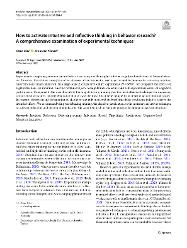| dc.contributor.author | Isler, Ozan | |
| dc.contributor.author | Yilmaz, Onurcan | |
| dc.date.accessioned | 2023-10-19T15:12:44Z | |
| dc.date.available | 2023-10-19T15:12:44Z | |
| dc.date.issued | 2022 | |
| dc.identifier.issn | 1554-351X | |
| dc.identifier.issn | 1554-3528 | |
| dc.identifier.uri | https://doi.org/10.3758/s13428-022-01984-4 | |
| dc.identifier.uri | https://hdl.handle.net/20.500.12469/5521 | |
| dc.description.abstract | Experiments comparing intuitive and reflective decisions provide insights into the cognitive foundations of human behavior. However, the relative strengths and weaknesses of the frequently used experimental techniques for activating intuition and reflection remain unknown. In a large-scale preregistered online experiment (N = 3667), we compared the effects of eight reflection, six intuition, and two within-subjects manipulations on actual and self-reported measures of cognitive performance. Compared to the overall control, the long debiasing training was the most effective technique for increasing actual reflection scores, and the emotion induction was the most effective technique for increasing actual intuition scores. In contrast, the reason and the intuition recall, the reason induction, and the brief time delay conditions failed to achieve the intended effects. We recommend using the debiasing training, the decision justification, or the monetary incentives technique to activate reflection, and the emotion induction, the cognitive load, or the time pressure technique to activate intuition. | en_US |
| dc.description.sponsorship | CAUL; Think Forward Initiative; ING Bank; Deloitte; Dell Technologies; Amazon Web Services; IBM; Center for Economic Policy Research-CEPR | en_US |
| dc.description.sponsorship | Open Access funding enabled and organized by CAUL and its Member Institutions. This research has been supported by the Think Forward Initiative (a partnership between ING Bank, Deloitte, Dell Technologies, Amazon Web Services, IBM, and the Center for Economic Policy Research-CEPR). The views and opinions expressed in this paper are solely those of the authors and do not necessarily reflect the official policy or position of the Think Forward Initiative or any of its partners. | en_US |
| dc.language.iso | eng | en_US |
| dc.publisher | Springer | en_US |
| dc.relation.ispartof | Behavior Research Methods | en_US |
| dc.rights | info:eu-repo/semantics/openAccess | en_US |
| dc.subject | Dual-Process Theories | En_Us |
| dc.subject | Cognitive Reflection | En_Us |
| dc.subject | Analytic Thinking | En_Us |
| dc.subject | Time-Pressure | En_Us |
| dc.subject | Decision Justification | En_Us |
| dc.subject | Registered Replication | En_Us |
| dc.subject | Cooperative Behavior | En_Us |
| dc.subject | Social Desirability | En_Us |
| dc.subject | Increases Belief | En_Us |
| dc.subject | Response-Time | En_Us |
| dc.subject | Intuition | en_US |
| dc.subject | Reflection | en_US |
| dc.subject | Debiasing training | en_US |
| dc.subject | Induction | en_US |
| dc.subject | Recall | en_US |
| dc.subject | Time limits | en_US |
| dc.subject | Justification | en_US |
| dc.subject | Cognitive load | en_US |
| dc.subject | Monetary incentives | en_US |
| dc.title | How to activate intuitive and reflective thinking in behavior research? A comprehensive examination of experimental techniques | en_US |
| dc.type | article | en_US |
| dc.authorid | Isler, Ozan/0000-0002-4638-2230 | |
| dc.department | N/A | en_US |
| dc.identifier.wos | WOS:000869348300004 | en_US |
| dc.identifier.doi | 10.3758/s13428-022-01984-4 | en_US |
| dc.identifier.scopus | 2-s2.0-85140018572 | en_US |
| dc.institutionauthor | N/A | |
| dc.relation.publicationcategory | Makale - Uluslararası Hakemli Dergi - Kurum Öğretim Elemanı | en_US |
| dc.authorwosid | Yilmaz, Onurcan/I-3839-2019 | |
| dc.identifier.pmid | 36253601 | en_US |
| dc.khas | 20231019-WoS | en_US |
















